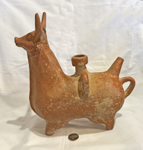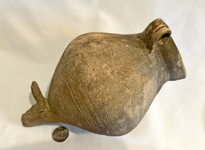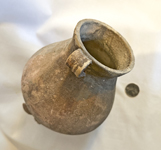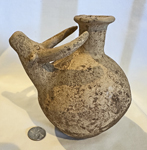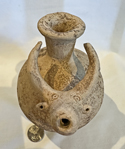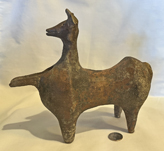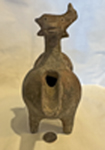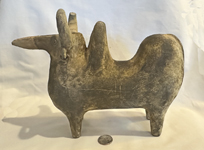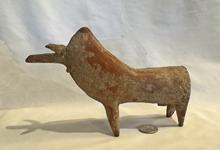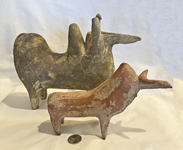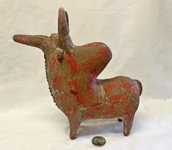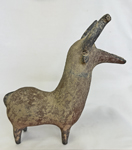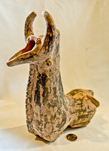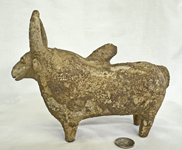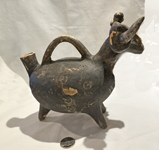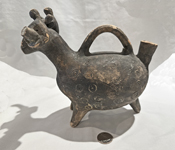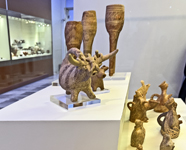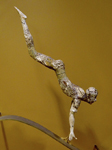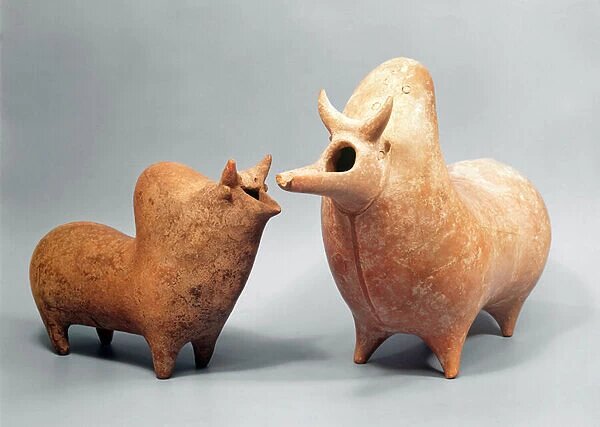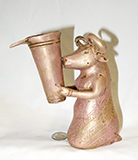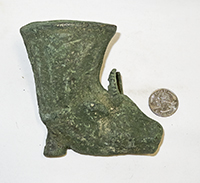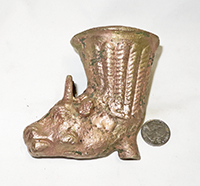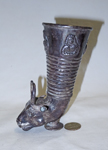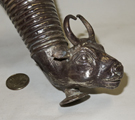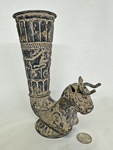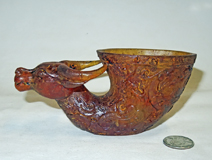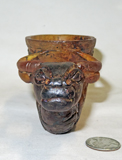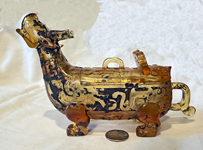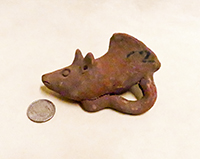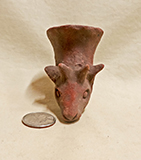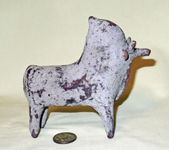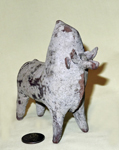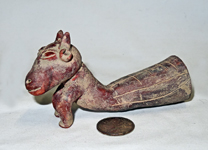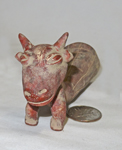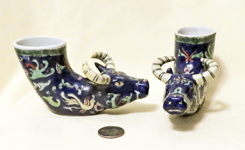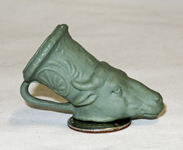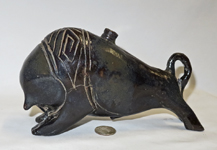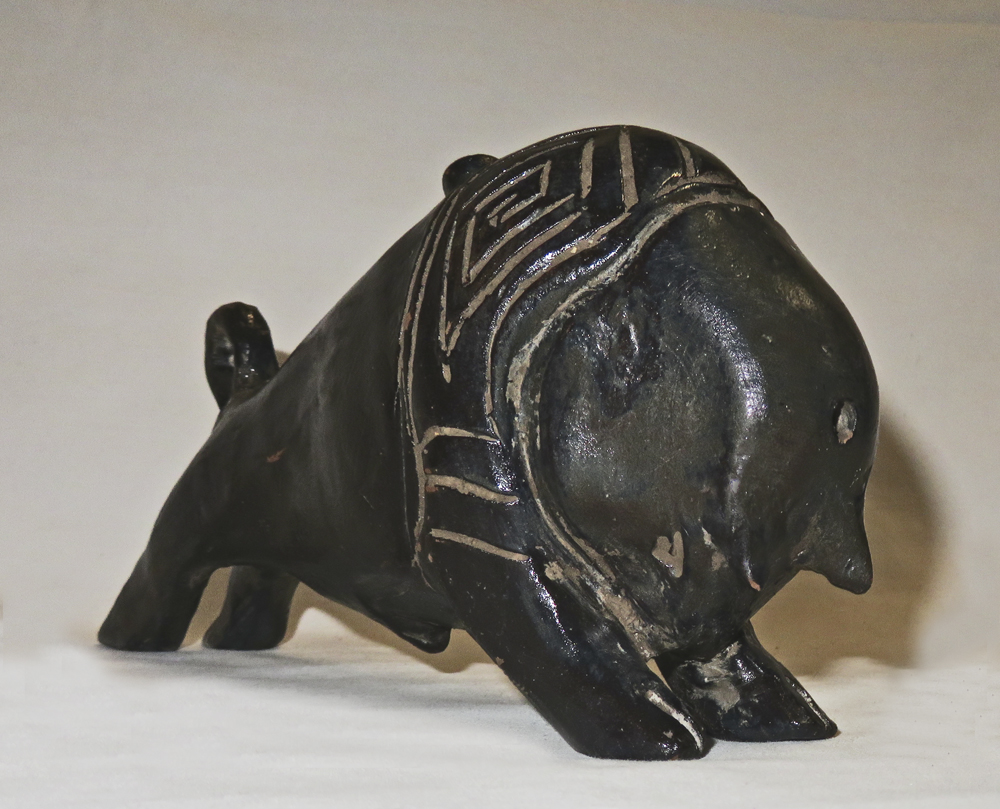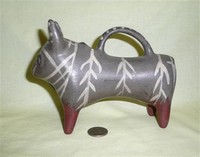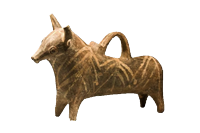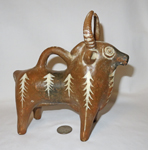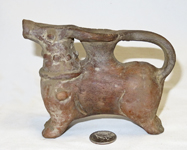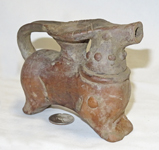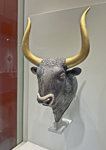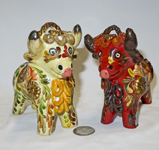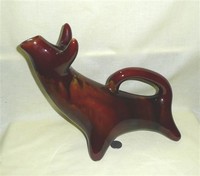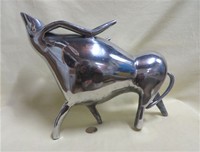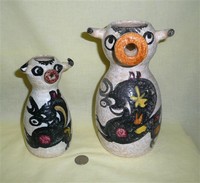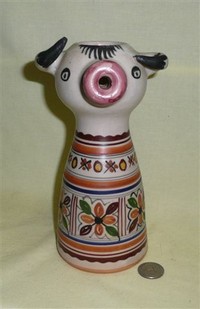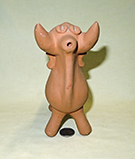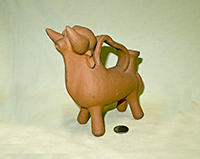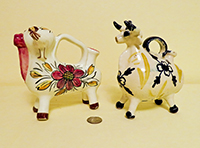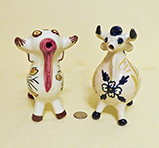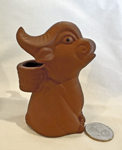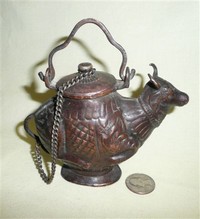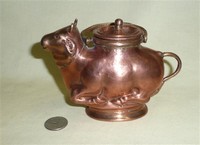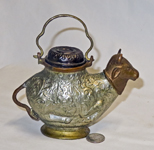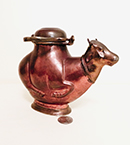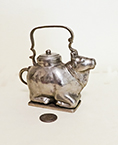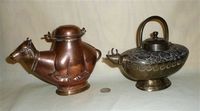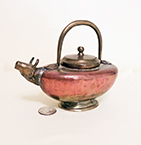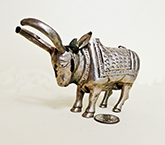Rhytons
plus Nandi and a few other liquid dispensing vessels
My Webster’s third International Dictionary defines rhyton as “an ancient Greek
drinking horn of pottery, usu. having the base in the form of the head of an animal,
woman, or mythological creature.” Wikipedia is much more expansive, stating
“A rhyton (plural rhytons or, following the Greek
plural, rhyta) is a container from which fluids were intended to be
drunk or to be poured in some ceremony such
as libation. The
English word rhyton originates
in the
ancient Greek
word ῥυτόν (rhy̆tón or rhŭtón). The conical rhyton
form has been known in the Aegean region since
the Bronze Age,
or the 2nd millennium BC. However, it was by no means confined to that region. Similar
in form to, and perhaps originating from,
the drinking
horn, it has been widespread over Eurasia since prehistoric times. (note: I saw some
great Parthian examples in a museum in Ashkabad, Turkmenistan) … Many vessels considered
rhytons featured a wide mouth at the top and a hole through a conical constriction at
the bottom from which the fluid ran. The idea is that one scooped wine or water from a
storage vessel or similar source, held it up, unstoppered the hole with one's thumb, and
let the fluid run into the mouth (or onto the ground
in libation)… Rhyta
were often used for liquids that needed straining, such as wine, beer and oil. Some
rhyta were used in blood rituals and animal sacrifice. In these cases, the blood may
have been thinned with wine. Some vessels were modeled after the animal they were
intended to be used with during ritual, but this was not always the case… Rhyta occur
among the remains of civilizations speaking different languages and language groups in
and around the Near and Middle East, such as Persia, from the second millennium BC. They
are often shaped like animals' heads or horns and can be very ornate and compounded with
precious metals and stones.” The Google ‘Images of Rhyton’ page has some 181,000
pictures, and while the majority are of the horn-shaped form, there are also many that
feature a full-bodied caracature of a cow, bull, or other creature, molded much like the
‘modern’ cow creamer or pitcher. Indeed, some of those pictures are of works from
modern artists’ (including William Morris).
This section of my collection includes few of the very fancy ancient (BCE) rhytons like those shown on the History page. – most are either in
museums or extremely expensive. It does however have some that are representative of the early ones, a number acquired on eBay from the highly
reputable MDAntiquitiesfirm in the UK (most of the terracotta ones seem to have come from a collection in Canada) plus a
few that appear to be copies of ancient ones, as
well as modern vessels that are designed for uses similar to those for which rhytons were intended. Thus
here I include the Peruvian Toritos de Pucara, which originally were used to hold chicha and blood for the
cattle branding ceremony as described on the Places page. Probably inappropriately, I have also put here a
number of Spanish bull caricature vessels designed for wine or oil and vinegar (popular tourist items), as
well as other cow or bull caricatures that might best be termed ‘cruets’ but which have shapes somewhat
reminiscent of some of the early rhytons. And, I’ve snuck in a couple liquor dispensers and what I believe
to be an old Chinese soy pot, for lack of a better place.
More appropriately, I have added a section at the
bottom of this page for my Hindu Nandi – designed for libations of holy water in Hindu Temples devoted to
Shiva – since they, and the somewhat similar cow-headed vessels used to hold ghee to feed the holy flame, have
ritualistic purposes.
As a reminder, click on any thumbnail for a larger picture.
Meet "Marduk, The Bull of Utu" (My wife liked it so much she insisted we name it - one of the few in my collection so honored).
Actually this is a lovely 800 BCE Amlash (Per Wikipedia, The term Amlash culture refers to an assortment of historic materials
and periods in Gilan and west of Mazandaran, in north of Iran. Amlash refers to the geographical region from which
some archeological objects of certain types come It does not have any real archeological meaning when used with the word culture.)
terracotta rhyton vessel per the Certicificate of Authenticity from MD Antiquities LTD of Didcot, Oxfordahire, UK.
They offer a very large number of items on their eBay site and many of the rhyton styled items in my collection have come from them.
This lovely bull is in amazingly fine condition, although its head appears to have at some point been broken off and carefully put back on.
|

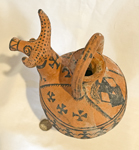
A second lovely rhyton from MD Antiquities LTD, this is said by them to be a museum quality Parthian terracotta rhyton vessel.
Wikipedia informes us that "The Parthian Empire , also known as the Arsacid Empire
was a major Iranian political and cultural power in ancient Iran from 247 BC to 224 AD.
Its latter name comes from its founder, Arsaces I, who led the Parni tribe in conquering the region of Parthia
in Iran's northeast, then a satrapy (province) under Andragoras, who was rebelling against the Seleucid Empire.
Mithridates I (r. c. 171 – 132 BC) greatly expanded the empire by seizing Media and Mesopotamia
from the Seleucids. At its height, the Parthian Empire stretched from the northern reaches of the Euphrates,
in what is now central-eastern Turkey, to present-day Afghanistan and western Pakistan. The empire, located
on the Silk Road trade route between the Roman Empire in the Mediterranean Basin and the Han dynasty of China,
became a center of trade and commerce." When I indquired I was told that this was fron the estate of a major collector in Canada,.
|
From the same dealer, an "Ancient Amlash Terraotte Bull Rhyton Vessel, super rare, excellent condition"...likely also
from the same Canadian collector. It's interesting in that there is a hole at both ends. Presumably one put a
finger over the bull's's mouth, filled the jug, then diapersed the liquid - to the ground or an altar if for an offering,
to the mouth if for wine. Still shows marks from when the body was made on a potter's wheel. |
Another ancient Near Eastern Amlash bull rhyton vessel...I'm particularly fond of this one because it clearly fits my
criteria of a fill and a pour hole. Plus it has a very endearing face. I'm continually amazed by how well these things
have survived...assuming that they are as advertised.
|
Anbother Amlash bull rhyton, closer to what I believe is the traditional style - missing a horn and a couple ears, but with a
winsiome face and a price I couldn't resis. .
|
Two more "Near Eastern Amlash Terracotta Rhyton Vessels" per MD Antiquities. Neither perfect - the larger one his missing part of a
horn and an ear and has had the end of its its mouth restoresd, and the smalkkler has tips of both horns slightly broken off.
The larger of the two has scratches on the sides - intentional or not I have no idea,. Interestuing are
the variations in interpretation of size and number of humps. |
|
This one's hump is sort of pointed to the rear - or maybe it is an old guy whose hump slumped. Interesting red marks and eyes, and holes
in the small ears for earrings. It apparently was broken into at least three pirces, but has geen beautifully restored.
|
This old long-necked Amlash bull rhyton (again from MD Antiquities) is in fine condition, missing just the very tip of the right
horn. It has no hump - but makes up for that lack with inscribed eyes and holes in the ears. I assume it once had earrings, or maybe plugs. Too ancient for ear buds. .
|
|
Again...inscribed eyes, holes in ears - kneeling this time, with a chest ridge. This one really does seem to be in too good condition to be real and old.
Oh well...not very prices.
|
This one with a small backwards leaning hump looks more like a regular buul or cow than those with the long snout. Its hole is on the rump.
|
Strange but interesting. This Near Eastern Amlash Terracotta Rhyton Vessel (per MD Antiquities)
has 3 legs, prople (men presumably) handing onto its horns
and head, and little circles with dots in the canter all aound the body. It seems to have had
considerable use because several spots are rubbed - at least I assume that accounts for the
orange coloration. |
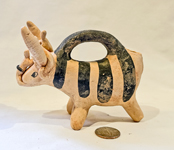
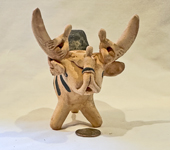
It turns out that the one above is not strange at all. When I visited the marvelous Archaeological Museum of Heraklion in Crete, this
little guy with what they reffred to as 'leapers' on his nose and horns was available in the gift shop. And yes, three legs. The card with it says it was
inspired by an exhibit at the museum, "Koumasa, Early Minoan II-III c2300BC". Its creator is Idols Art, Myrto Politaki.
So I looked up 'bull leaping'. Minoan civilization flourished in Crete from aroung 3100BC to 1100BC. The icinography of the
bull permeates Minoan culture. Bull leaping, famously portrayed in a fresco from Knossos, was a popular
ritualistic sport or taurokathapsia (ταυροκαθάψια), a combination of sport, religious ceremony, and social tradition
where athletes artistically vault over a leaping bull.... I guess that's a bit hard to repproduce in a clay rhyton,
so the little leaopers here seem to be holdong on for dear life.
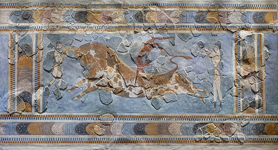
To at least partially complette the story or my lovely rhyton, here - from the museum - are my photo of the original
version accompanied by friends in its case,
and - borrowed from Wikipedia because I couldn't get a decent picture due to lighting - an small ivory model of a leaper like in the
fresco, also from the Palace of Knossos.
|
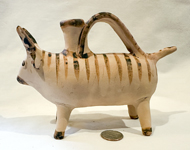
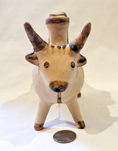
Just after I got the leaper bull, we visited Katakolon, Greece, home to ancient Olumpia. Lo and behold, there was this
little guy in a shop downtown.I'm niot sure what he is intended to hold, or if like the leaper bull he's a replica of an
ancient one, but he seems to belong here with near relatives. I particularly like his tail.
|
|
These ancient bull rhytons are sufficiantly interesting that I felt it not inapproipriate to include here this article and accompanying picture from the Tehran Times
of January 27 2024 entitled "From pottery to burial practices: delving into the artistic legacy of Amlash civilization".
TEHRAN – The Amlash civilization primarily flourished in what is known as Iran’s Gilan region, situated along the southwestern coast of the Caspian Sea.
It was an Iron Age culture, which was thriving from approximately 1000 BC to 600 BC, and derives its name from the Amlash River in Gilan.
Key features of Amlash art include distinctive pottery, bronze artifacts, and terracotta figurines, mostly depicting reddish-brown or black hues. In fact, Amlash pottery is distinguished by its unique shapes and intricate decorative elements. Bowls, jars, and vessels often showcase elaborate designs, featuring geometric patterns, animals, and human figures.
Amlash art reveals influences from neighboring cultures, such as the Elamites and ancient Iranians. The cultural exchange in the region is evident in the artistic motifs and styles found in Amlash artifacts.
Moreover, Amlash artifacts are frequently associated with burial sites. Archaeological excavations have uncovered graves containing pottery, bronze items, and figurines, suggesting a deep connection between Amlash art and burial practices.
Numerous Amlash artifacts have been unearthed through archaeological excavations in the Gilan province and surrounding areas. These discoveries significantly contribute to our understanding of Amlash culture and its artistic expressions.
Amlash was strategically positioned along trade routes, facilitating cultural and economic exchanges with neighboring regions. This trade likely played a pivotal role in incorporating external influences into Amlash art.
So far, several archaeological sites have been unearthed in Gilan province with links to the Amlash culture. Excavations at sites like Marlik, Hasanlu, and Ziwiye have revealed significant artifacts, providing valuable insights into the material culture of the Amlash people.
Amlash culture is often associated with burial mounds, where individuals are interred along with various grave goods. These burial practices offer valuable insights into the cultural beliefs and rituals surrounding death and the afterlife.
The Amlash culture interacted with other contemporary cultures, such as the Urartians, Elamites, and Medes. This interaction is evident in the artistic motifs and elements found in Amlash artifacts.
The production of bronze artifacts by the Amlash people showcases their proficiency in metalworking. The use of bronze for tools, weapons, and ornaments indicates a high level of technological advancement in metallurgy.
Many Amlash artifacts are believed to have had ceremonial or ritual significance. The presence of specific symbols and iconography on pottery and figurines points to their utilization in cultural practices or religious ceremonies.
Amlash art showcases a remarkable level of artistic innovation, especially in the creation of terracotta figurines. The stylized representations of human and animal forms suggest a unique artistic expression within the cultural context of the time.
Moreover, the Amlash culture produced bronze objects, encompassing tools, weapons, and ornaments. Bronze items associated with the Amlash culture were meticulously crafted using advanced metalworking techniques of the time.
A notable aspect of Amlash art is the creation of terracotta figurines. These figurines depict humans and animals, characterized by stylized features, often portraying individuals in various poses, including sitting or standing.
Ongoing archaeological research in Gilan province continues to unveil new aspects of Amlash culture. Ongoing excavations and studies contribute to a deeper understanding of this ancient society and its significant contributions to the broader cultural landscape of the ancient Near East.
The Amlash culture, apparently, did not adhere to a centralized political system with a single ruler or king. Instead, it is believed to have been a society composed of smaller communities or tribes in the Gilan region during the Iron Age.
According to sources, the political organization of the Amlash people is not well-documented, and the available archaeological evidence does not provide clear information about a specific ruling authority.
As mentioned before, Amlash art is renowned for its terracotta figurines, with representations of animals, including bulls, being particularly common. These terracotta bulls offer valuable insights into the artistic and symbolic expressions of the Amlash people during the Iron Age.
The terracotta bulls from the Amlash period are typically small figurines made of baked clay. They include stylized depictions of bulls, often with simplified forms and symbolic elements. These figurines may have held cultural, religious, or ritual significance within Amlash society.
Interpreting such artifacts involves understanding the cultural context in which they were created. Bulls held significance in many ancient cultures and could be associated with fertility, agriculture, strength, or religious beliefs.
Archaeologists and historians utilize these artifacts to piece together the history and lifestyle of the Amlash people during the Iron Age in the ancient Near East.
|
This, per the ebay seller MD Antiquities of the UK, is a bronze Persian rhyton circa 300BC.
It came with a lot of verdigris which I decided to remove, and it looks quite nice with the bronze
exposed and shiny. This bull is a very interesting and heavy bronze piece, and nicely fits the Rhyton
definition since it certainly appears designed to pour a libation of come sort. The seller said they
usually came in sets (a similar one was sold on eBay shortly before this one), and there would have been
many around a round table. I have no experience with antiquities like this, but hope to learn more.
|
From the same UK seller came this Persian bull head rhyton - in this case more like a drinking vessel - said to be @400 BC.
It was heavily encrusted but after several days in vinegar and a bit of light brushing it came somewhat clean, nicely
displaying the bronze.
|
Here's another superb rhyton, in this case one made for drinking rather than simply pouring.- sort of like English 'stirrup cups'
-from MD Antiquities - said to be "circa 500BCE Ancient Persian hand beaten
silver rhyton vessel". I checked it and a magnet didn't stick and the test acid left a small mark, so I believe
it is indeed some form of silver, although it doesn't shine up very well. Not surprising given its age, I guess.
Like the two above it came looking like it had been buried for a while - dust and dirt.
|
| |
A second drinking rhyton, this time sold by MD Antiquities simply as 'ancient near eastern'. It's heavy
earthenware with a teaL colored glaze, now heavily cracked.
My wife thuiks it's neat andthe color matches many of her pots,
so it goes on display in our living room. We got it the day of the 2024 election
so she named it 'Kamela' because like VP Harris it's very nice looking has its neck stuck out. |
| |
This simple drinking bronze rhyton with a bull protome may be one of my oldest - from the Archaemenid Empire circa 500BC
according to MD antiquities. My visit to Wikipedia yielded:"The Achaemenid Empire or Achaemenian Empire, also known as the
Persian Empire or First Persian Empire (/əˈkiːmənɪd/; Old Persian: Xšāça, lit. 'The Empire' or 'The Kingdom' ),
was an Iranian empire founded by Cyrus the Great of the Achaemenid dynasty in 550 BC. Based in modern-day Iran,
it was the largest empire by that point in history, spanning a total of 5.5 million square kilometers (2.1 million square miles).
The empire spanned from the Balkans and Egypt in the west, West Asia as the base, the majority of Central Asia to the northeast,
and the Indus Valley to the southeast." This lovely rhyton was said to be 'rare' - and is in great shepe with very
little corrosion and no dings. Makes one woneder... |
| |
I need help with this one - very similar, bronze, but tiny. I have seen other tiny ones both like this and in somewhat different forms,
but can't fathom what they
may have been used for. Bought from a crete seller, said to be from 1000-500 BC. Inexpensive enoiugh, and it makes an absolutely
superb addition to my miniatture collection...where it is also shown. |
| |
This one, also Archaemnid (and very rare per MD antiquities - albeit they sold 2 others similar) bronze drinking rhyton
with bull protome rivals the one above for age. Somewhat fancier, lighter, embossed with decorations and mules, and with a few
missing pieces of the outer layer. |
| |
OK, these two break ALL the rules. BUT - since I welcomed drinking rhytons from the near east and said they were like
English stirrup cups, I figured I owed it to
the fox hunters of England to throw in their versions - here pewter stirrup cups by Towle. The name comes from the practice
of offering a farewell drink to your guests when they are alrerady in the saddle and ready to ride off ...or perchance
to have a bit of a toddy to warm up a tad before plaguing the poor fox. |
| |
.If those weren'e bad enough, here's a Chinese bronze version. Just a cup, no strrup. |
This one, also from MD Atiquities, was advertised as a museum quality ancient near eastern rock crystal
rhyton vessel with a bull's head. It is nicely carved, it certainly appears to be rock crystal of
some sort (whatever that is) and came clean. I feel it was well
worth the $80 and is a quite different addition to the collection. I wish I know of some way to verify
the nature of these things - but I think that even the dealers have trouble. Lots of things are getting
smuggled out of the middle east these days, and of course folks are still making 'antiquities',
so I imagine that even experts make mistakes. With its huge number of items and guaranties of antiquity,
I believe MD Antiquities to be one of the more trusted dealers. I certainly buy with finger-crossed confidence from them.
|
|
|
Although amber glass like the one above, this flagon or rhyton is distinctly Chinese. It came from an ebay site called
"hongsan-culture" that shows well over 4000 items...so many that it seems to loose track of them. The first one I tried to
buy from them they never found, and it took them a couple weeks to locate this one. It was heavily encrusted (a sign of age perhaps)
and I removed part of that. Interesting interpretation. |
The UK seller from whom I purchased this little vessel on ebay stated in his description that it is
Viking terracotta rhyton dating from around 250-350 AD, and came from a private 1970s collection of
Eastern European items. It's too small to be useful for drinking (except perhaps for a very tiny Viking)
and is unglazed so not really suitable for liquids meant to be consumed. He also stated that it's unusual
in that it bears a fertility symbol (which I have been unable to locate). But then, he also said exactly
the same thing about a similar gost's head piece, so I am beginning to doubt all the above. And, later
he advertised an identical piece with another story, so it seems it's a modern fake. Nonetheless, it was
very affordable and sorta looks like a 'drinking' rhyton...and it's fairly interesting in its own right,
if crude. |
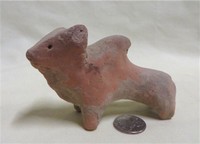 |
Well, this was sold as a rhyton, and although it has no holes it does seem to be
a cute little bull effigy. It was said to be Amlash, 1st millennium BC, and came
certified as original from an antiquities dealer
in Cyprus. It was sufficiently inexpensive as these
things go that I thought it would make a good contribution to this part
of the collection. Amlash is a fairly generic term referring to a geographic region
in northern Iran, and apparently most of the artifacts
from there date to the 9th-8th century BCE. A check of the photos on
google shows that hump backed bulls seemed to be popular items for Amlash
rhytons. |
This was sold as a 'superb beautiful small terracotta Amlash bull rhyton, rare', by a company in Whitby,
Canada, that had only been sellng on eBay for a couple months. It is indeed really cute, and has a hole in
the snout. It is in great condition, and has a nice Amlash shape. The seller's description said it was original,
but of unknown age and place of origin. Having bought it with Canadian dollars, I was somewhat surprised ro find
whwn it arrived that it was shipped from Farid & Mirrwais Novelties Trading, Umm Ramool, Dubai UAE.
This I'd guess its age as a couole months, and its origin as Dubai, UAE and yes it probably is rare,
because I doubt they could count on selling many of these. I could of course be wrong and I hope I am,...but as the old saying goes,
you pay your money, you take your chances. Whatever,I do like it, and at least it didn't cost the umpteen
thousand dollars that I have seen Amlach rhytons on offer for.
|
This one is, to my mind, quite cute. It was described on Ebay as "Ancient Persian Terracotta Rhyton Vessel with bull head, Rare", from a seller said to be in Hing Kong. It was mailed to me from New York. OK...I'd give it about a 3% probability of being as advertised. If it is, great. No way that I know of to verify...but then I didn't expect a lot, just thought the shape and round ears and stubby front legs were interesting. It doesn't take a lot of room on the shelf. |
|
|
This one came from the same Hong Kong seller as the one just above. It's also just as unlikely to be Ancient Persian as advertised - but I assume someone had fun making it. It was cheap enough and interesting enough that in spite of almost certainly being a fake or rather reproduction, I decided to get it. |
>
I got the cloisonne-like drinking rhyton on the left a number of years ago from an Enlish seller who thought it was Chinese. Then the two on the right cane up on eBay and I guess I didn't compare well enough because it turns out that they are the same as the other one, only with a dark blue background. The English seller of these said she got them at an auction in Workingham, Berkshire around 2003 and that the auictioneer said they had belonged to a merchant mariner and he thought they were Persian. Whatever...they are quite lovely and make a nice addition to the colelction.
|
|
Here is another drinking horn or rhyton, this one a very special dollhouse cow or rather bull, more modern than the ancient ones
but with a bit of age nonetheless (It is also featured on the Miniatures page). The English seller acquired it at a "very fanous" toy and
doll auction, where the specialist informed her it was Edwardian, made by Wedgewood. The jasper coloration and beautiful molding certainly
attests to that origin. Doll houses were very populaer in that era which is what likely induced Wedgewood to enter the game(the seller has a
few others by them from the same coillection and auction, but this was the only cow/bull). |
|
This one is a second take on the same theme. In this case, a new Greek drinking rhyton fashioned by Emanuela Valenza of LaboratoriodiManu
in Genoa Italy. She makes magnificent dollhouse miniatures, available on Etsy. And of course it is also featured on my Miniatures page |
This massive bull was sold as a "Celtic ritual rhyton Viking Bull AD 200-400". The interlocking diamonds on its shoulders do seem to match the description. It came to me from an antique dealer in Ebbs Austria who seems to largely specialize in coins. He kindly told me that he acquired it from the heirs of a serious collector from Munich, Germany who had bought it in an antique shop in Oslo, Norway. It is interesting in that it has both a raised fill hole, and a pour hole...in its forehead. I tried if and it does pour, albeit a bit sloppily. Perhaps it was intended for a ritualistic liquid somewhat more viscous than water.
| /
My modern red-clay jug with the grey glaze and stylized markings bears a
close family resemblance to this Cypriot rhyton whose picture I downloaded from
google’s rhyton images. The seller said she’d like to think that it was Cretan or
Etruscan, and it turns out she was pretty close.
|
|
Thuis is a 2022 reproduction rhyton from the Nicosia Museum on Cyorus. The seller states
"The bull was one of the paramount religious symbols of Eastern Mediterranean peoples in the Late
Bronze Age and was linked with fertility as well as with supernatural strength. It frequently
assumed the form of major male deities, such as Apis in Egypt, Anu in Mesopotamia, El in Canaan,
and so on, while in Minoan Crete it developed into a symbol of both religious and royal authority.
In Cyprus, the religious connotations of the bull are attested already from the Early Bronze Age,
when clay bucrania were placed on top of sanctuary models. They become even more obvious in the
Late Bronze Age with the production of several bull rhyta and the adornment of altars with stone
or clay bull horns. Please be aware that, due to the fact that our products are either
individually cast, carved, hand painted and hand finished, there will inevitably be minor
variations in size, colour and texture." It is indeed a very fine piece.
|
|
|
Per its tag, this nice replica is a "Greek Articfact of the Neolithic, Cycladic and Archaic Period,
4000BC-400BC", and on the other side, "Bull shaoped rhyton from Philakopi (Milos), 14th cent BC".
Amazibng that the original was (presumably) in sufficiently good shape to enable the construction of this replica. Its horns
have been repaiored but it displays nicely.
|
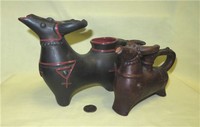 |
Both of these stylized bulls came to me from the UK. With their large swept
back horns and conjoined legs as well as the symbols on the sides they’re clearly
intended to be reproductions or at least representations of some earlier ritualistic
vessel.
|
Several years after I got the two above, this one showed up and is alledged to be an
original from which the reproductions may have been modelled. This one cane from the same seller, and
indeed from the heirs of the same Munich collector, bought at the same time as the Celtic bull above..
The Ebay description said it is Greek pottery, a Cypriot, Ascus, Ritual Vessel dating from 800-600BC. In r
espone to my query the seller indicated that the collector's notes indicate it was purchased bin March 2017
from "non-professional archaeologists from Turkey, who found it near the present-day town of Tasucu,
which is not far from the town of Mersim." I'm not at all sure what to think about 'non=professional
archaeologists' but I guess there are legitimate such. At any rate it's very hard clay and in good
condition and I'd like to believe it is as advertised. It certainly bears a very close reseblance to
the reprocuctions, albei when I biught them they came with no further informaion..
|
I took this photo of the original of the famous Minoan bull's head rhyton in the wonderful Heraklion Museum, in
Crete. It is black steatite, jasper, and nacre, 1550-1500 BCE. There were nice copies in a variety of size and materials available in shops downtown, but I already had this tiny
replica of it, and decided that it was adequate. No need for two 'fakes'. The museum actially had other bull head rhytons,
but this one seems to be the most popular because there were no copes of the others, and this one keeps showing up on
postcards and copies on eBay.
|
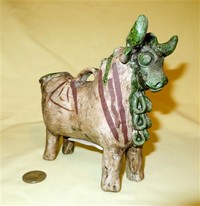 |
This is a Peruvian Torito de Pucara. Rhyton ‘purists’ would probably object
because there is no Greek or Persian heritage here, but rather a combination of Spanish and
indigenous Andean. However as noted in other places where I have displayed these
lovely bull vessels (see expecially Pery on the Places page), they were initially designed for rituals associated with the
cattle-branding ceremony, to hold a mixture of blood and chicha (corn-based beer).
Thus they certainly meet the basic (expanded) definition. They have become a very
popular souvenir of Peru, and also are often found in pairs on newly-completed roofs
of houses, bearing a bottle each of chicha and holy water.
|
 |
Here are two more Toritos, both acquired from Novica which sells products
from artisans around the world to folks like me. The large greyish one is by Walter
Jose Acosta, from the Huambo province in the Amazon region of Peru, who is
dedicated to perpetuating the beauty of Peruvian ceramic art. The little black one
is by Maribel Posso Olivares who with a friend now heads a workshop with about 12
artisans, creating ‘alasitas’ which are tiny items reflecting wishes. Novics states that its mission
is to spread happiness to both the artisans and to their customers, and their items come beautifully
(and safely) wrapped, and in the case of these two, with little dolls attached to the red bows.
|
Yet three more - the bright ones on the left were sold as Mexican cow jugs but are pretty obviously Toritos. They are wildly painted and also very light, more like some sort of plastic rather than clay. On the right is a more traitional clay one, definitely Peruvian.
|
|
The larger one here was my very first Torito, although at the time I didn't know what it was - I just thought it was a neat Mexican bull, available at a church yard sale for a nickel. The little ones came much later. They have the classic form, but just are tiny to serve as alasitas, or to appeal to tourists with small bags. They also will appear on the Miniatures page.
|
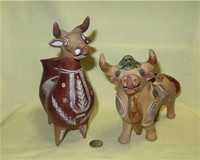 |
Two more from Peru – the one on the right is a version of the Torito, and the
other a quite different stylized version of a bull. Its tongue very nearly covers
the hole in its nose. When my wife and I visited Peru we encountered a very large
number of marvelous old pottery figures, some quite scatological and all fanciful,
in the museums. As noted above, bulls were not native to the area so this type of
figure appears only after the Spanish conquest.
|
|
Here is a small facsimile of how the Peruvians often
display the toritos on their homes. To quote the seller who was from Cuzco “The
torito of pucara is a ceramic handicrafts of the district of Pupuja, in the province
of Azángaro, Peruvian department of Puno. It is a totemic symbol known as qonopas
(Quechua) and / or Illas (Aymara), used in Andean rituals and ceremonies of
protection, happiness and fertility in married life. In the perception of the Andean
settlers that the pair of pucará toritos on the roof is a sign of protection and
happiness in the home, it is an Andean duality that represents the husband and the
woman that represent the fusion of positive and negative energies that the
Equilibrium And the common good. At present, this piece has become a symbol of
Peruvian Andean identity. The singular finish of the toritos are imperfect figures,
of rough aspect, although they are charming and handmade in all ways. The objects
are tied with the sheepskin and the black color is because they are destined to be
buried in the day of the Pachamama the 1 of August of each year.”
|
|
No, Dolls are not generally part of the dollection. However this well dressed Peruvian lady - in addition to carrying 3 babies
(one on her back), a llama, and a pitcher of chicha - is cuddling a tiny torito de pucara,. Thus she is more
than welcome to grace this page.
|
Both of these large stylized bulls have just a single hole in the snout, and
bear a interesting resemblance to some of the ones I found on the google rhyton
images page. They’re clearly not made for cream or milk – but would serve well for
wine (or blood). The red glazed ceramic one came to me from Ontario Canada and the
only information the seller could provide is that he got it at an estate sale from
someone who had an extensive pottery collection, and that it’s most likely Blue
Mountain or CCC pottery.
|
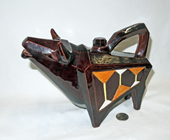
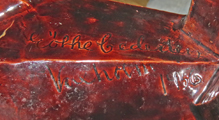
This large brown bull with a stopper on its back seems to have 3 martini glasses on its sides. It's signed, but I sure can't decipher it. The seller said it came from Sweden, so perhaps at one point it contained aquavit, and was used for libations to Thor or Odin (or Loki or Freya or...).
|
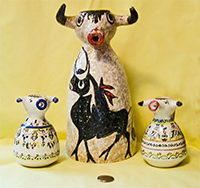 |
Here starts a series of cow shaped containers that likely have no ritualistic purpose, but don't
really fit in other pages of this web site. We begin with a pair of Spanish cruets from Seville, presumably designed
for oil and vinegar (and for sale to tourists). The large one with the bull on its belly is intended, I believe, for wine.
|
On the left are two wine pitchers decorated with an impressionistic bull. They're
meant to be mother and child I guess since only a Mom could love a face like that. Sharing this
section is a similarly shaped vessel from Mexico.
|
This interesting “Punter” signed pitcher comes from the workshop of fifth generation ceramicist Domingo Punter and his family (Artesiana Domingo Punter e Hijos, S.A,). located in the Plaza de Cathedral of Teruel (Aragon), a high altitude town in eastern Spain noted for its Mudejar architecture, a mix of Gothic and Islamic. I could not find a web site for them, but a number of other sites feature their pottery and tell us that the dark red clay from this region is very dense, and that their work is intended to reproduce the Spanish Romantic style of the 14c., thus the somewhat primitive designs and only the black and green colors of that period. This quite idiosyncratic cow or bull is dated ’57 and came to me from the Netherlands. The 'puckered' moith and large horns are reminiscent of other Spanish bull cruets and wine jugs, but the body and legs seem to be unique to ths family. The price on Ebay was quite low for work from the Pungter studio, but shipping made up for it.
|
This is a traditional clay piece from Cuenca, Spain. From what I can glean from a number of web
sites and a knowledgeable UK seller, it is an
example of Cuenca’s most typical pottery item, the so called "Toro Ibérico"
(Iberian Bull) which was originally created by the master potter Pedro Mercedes who
was inspired by an Iberian bull head from the 7c Moorish period which was found in
the town of Huete and is kept in the Museo de Cuenca. Apparently the modern ones became favored as
family gifts representing the spirit and courage of the Spanish or Iberian bull, a reputation gained
from bullfights. These cute little bulls proved to be very popular and have morphed into souvenirs,
as well as into vessels used - like those above - for oil and vinegar or perhaps wine.
|
 |
Here are a couple of the souvenir versions - much more gaudy than the traditional clay form. They
both have raised letters that read “Recuerdo de Cuenca” , Souvenir of Cuenca. The smaller one also
has an impressed seal on its right rump that reads “E. del Castillo Alfarero , Cuenca” and Emilio
Castillo’s ceramic studio is indeed in Cuenca Spain.
|
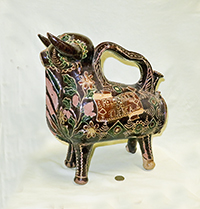 |
Some potters - and some tourists - apparently got carried away. This 'Recuerdo' is downright huge
and heavy.
|
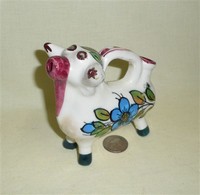 |
More reasonable in size, and much more common in the gift shops (and on ebay) are small 'Toros Iberico" like this one, suitable like the small bottle-shaped ones with bull's heads for oil and vinegar, and a bit too skimpy for wine. |
|
|
Here’s another of the same shape, this time with cats on the side,
advertising a holiday resort in Torremolinos, Costa del Sol, Spain. It was made in Spain and is
marked with a red crown over a cup with a V, over a blue wreath with
“Valdelvira” at the bottom. The popularity of the Toro Iberico has clearly spread well past Cuenca.
|
 |
This brightly decorated version with bulgy yellow eyes is made of red clay and is marked for “J.
Roig, P. Espanol, Barcelona”
|
|
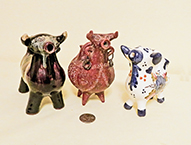
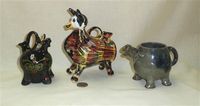
|
These small versions - some typical Iberain bull in form and others considerably more fanciful
- are likely intended to hold olive oil or something similar - but they probably have a right to be
on this page given that their shape is quite reminiscent of some of early ritualistic vessels. Then
again, for those on a Mediterranean diet, use of olive oil can indeed be considered a ritual. The
first one of these that my wife and I got was the reddish brown clay one with the earrings in the
middle of the upper picture. We purchased it in a shop in San Gimignano, Italy, in 1990. It carries
fond memories of a pleasant vacation in central Italy, and a fascinating old
town of nine towers. Great wine in the area, too! The only other one of these
that’s marked is the dark brown one on the far left of the upper picture: from Enesco, and made in
Japan. Perhaps it should be called a "Toro Nipponico". The little grey-blue cup with cow head spout
on the far right in the lower picture is hand made, and almost certainly comes from somewhere in the
US; the eBay seller was in Arizona. I conclude that the traditional Curnca Bull has indeed become
world-renowned.
|
|
Yet two more big ones for good measure
|
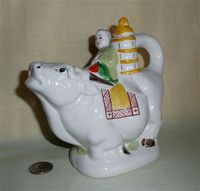 |
This interesting Russian liquor dispenser came, thanks to eBay, from a seller
in Vratsa, Bulgaria.
|
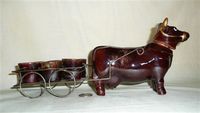 |
This bull pulling the little wagon with cups is a liquor decanter – its head
comes off for pouring.
|
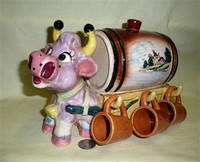 |
Here is another version of a liquor dispenser. There are some very lovely
French ones on the Faience page, but this one is quite obviously Japanese (and it
has a sticker that says so), labeled for “PAC” although it has all the
characteristics of several other cows scattered throughout that came from
Thames. Somehow I can’t imagine it holding sake. Indeed, I doubt that one like
this was ever sold in Japan – only some crazy American would ever buy something this
weird.
|
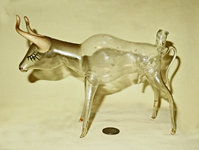 |
Some glass-blower has a sense of humor. Likely Italian? Seller made a few futile guesses at the maker but best
just to say I have no idea. Pretty obvious how this one works (the shadow makes that especially clear) - and it does have
2 holes so is fully qualified for the collection. It came with cork stoppers for both the in and the out orifices -
but like a suiteki, if the top fill hole is tightly pluged, he doesn't leak. Lovely eyelshes, too. I think I will use it
for slivovika which is clear as well as tasty. |
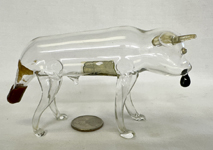 |
Nowhere near as well done, this little bull apparently operates through the tail. I doin;t know exactly what it held,
but the belly has a sticker from the Florida Liquor Commission. |
|
As if the one above wasn't bad enough, try this one..., I am embarassed to say that I actually paid money for it...although it was cheap.
The only saving grace is that it does meet the 2-hole criterion, even if the fill hole is
a basket and the 'pour' hole is between its feet. I think it was intended to amuse children. |
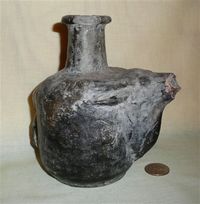 |
This is an old Chinese earthenware pot with the head of a bull or water
buffalo that the seller claimed is 17c Qing Dynasty; it’s beaten up enough to be so,
although it’s now against the law to export items from China that date from before
1911. It was most likely designed to hold water or, even more likely, soy
sauce.
|
NANDI – Hindu holy water pots and other temple cows and bulls
|
As I understand it (I get confused by Hindu deities), Nandi the white bull is Shiva’s vahana or
vehicle, the mount on which he rides. A note from the Philadelphia Museum of Art adds that “Shiva is
a great ascetic whose power emerges as contained sexual energy. Appropriately, he is accompanied by
the virile bull. An image of Nandi sits in the hall or porch of temples dedicated to Shiva, facing
into the sanctum like the primary devotee that it is.” In ancient India, he was also an independent
deity known as Nandikeshvara, the Lord of Joy, represented as a man with a bull’s head. The folks
who sold me this lovely older copper version – which comes from Jodhpur in Rajasthan – said that
these pots are used by priests to spray holy water on the devotees who come to worship at Shiva’s
shrine, or are carried by holy men to hold and disperse holy water from the Ganges. As you will
note, this Nandi arrived very carefully packaged for safety in an old tin for Kashmir Snow Beauty
Aids.
|
|
Here are two modern brass Nandi, both coming direct from India but without the fancy box.
|
|
This is a particularly nice example, with bronze head, tail, base and lid, but with a silverish body bearing an impressed Buddha plus the bull's legs and a lot of flowers and other decorations. |
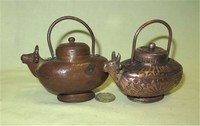 |
Here are two small nandi water pots. The one on the left with nicely inscribed marks was said to be
from Natal, but was shipped from Singapore. The copper one on the right is from India; it was very
dirty and tarnished when it arrived so I cleaned it up a bit.
|
Here are three more Nandi water pots in different configurations and types of metal, as well as
what I found out later were vessels for ghee, as explained in the next section.
|
I had thought that all these bull or cow shaped Hindu ritual vessels were models of Shiva’s bull,
used for holy water. Then the large and rather plain oval bodied ‘cow’ on the left arrived, from a US
seller. It contained a small leaflet entitled “Butter pot” that said “In India, the cow is believed
to be “close to God” and can fulfill dreams and desires. This brass cow’s head kettle is used to hold
the clarified butter, called Ghee, which fuels the holy flame that is kept lit at all time in Hindu
Temples”. As it turns out I had a few others of similar size and shape that I now believe to be
other versions of ‘cows’ not bulls, used for Ghee. They certainly are of a different shape and
character than the holy water nandis…but nonetheless because of their use in Hindu temples I believe
they belong in this part of the collection
|
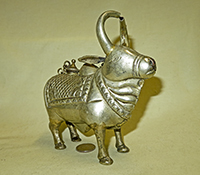 |
Straight from Ahmendabad in Gujarat, India comes this lovely brass (so said the seller) standing
nandi. Very different in shape and structure from my others, it is nonetheless designed for
holding and dispensing holy water…not through the mouth which has no hole, but rather through the
hollow horns. I don’t know if this has any ritual significance, but from my perspective it certainly
qualifies for the collection.
|
|
Here is a similar but smaller and somewhat less well crafted horn-pouring nandi. He looks a bit
dejected, but is nevertheless very cute. It’s interesting that after several years of collecting and
finding none of these, I bought this and the one above just a month or so apart. This one had a very
important feature – it cost 99 cents (plus something like 14x that for shipping)
|
|
|
Yet another variant – a copper “Shivling Holy Water Cow Face Cone” according to the London-based
seller. The add for it on eBay stated: ““All our Spiritual Products Are Spiritually activated With
Mantras & Puja’s also known as Abhisheka by our Panditji Priest without any extra charges. Ideal to
hang in temple over Shiva Linga – very auspicious to do Shiva Pooja” Naturally this sent me to
Wikipedia where I learned first that “Abhisheka, also called Abhishekam, is conducted by priests, by
pouring libations on the image of the deity being worshipped, amidst the chanting of mantras.
Usually, offerings such as milk, yogurt, ghee, honey, Panchaamrutam, sesame oil, rosewater,
sandalwood paste may be poured among other offerings depending on the type of abhishekam being
performed. This ritual is routinely performed in some Hindu and Jain temples. "Rudraabhisheka"
(Abhisheka of Rudra) is performed on Shiva lingams.” Seeking further, I also found out that “A pandit
or pundit is a scholar and a teacher, particularly one skilled in the Sanskrit language, who has
mastered the four Vedic scriptures, Hindu rituals, Hindu law, religion, music, and/or philosophy
under a Guru in a Gurukul or has been tutored under the ancient Vedic Guru-Shishya academic
tradition. The English loan word pundit is derived from it.”
|
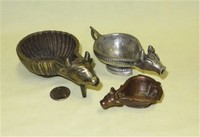 |
Finally, here are three open-topped Nandis – the largest and smallest came from Sunil Arts & Engg Works in Jodhpur, Rajasthan, India, and the silver colored one from a seller in the US who
presumably brought it back as a souvenir. The well crafted tiny copper Nandi was said to be 70-80
years old, and used in temples. The largest one, with a stand under its chin and with internal
ridges, was sold to me as a pot or ‘ash tray’ (which I doubt), but I have also seen an identical one
described on eBay as a Kharal, which is essentially a mortar for grinding opium and making ‘opium
water’ which is then taken through the bull’s mouth. Perhaps some kind Hindu can enlighten me – I can
only say that I’m learning, slowly, that holy cows and bulls from India can have many manifestations
and uses.
|
| |
|

